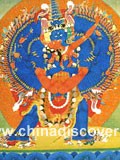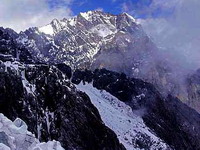Baisha murals

Baisha murals are mostly from the Ming Dynasty (1368-1644). Among the 55 existing murals, the largest one is at the Dabaoji Hall of Baisha. Most Baisha murals depict religious stories, and one characteristic is to combine several legends into one picture. They are an artistic Crystallization combining the Naxi, Tibetan, Bai and Han styles.
The world famous Lijiang Fresco mixed the stories in Buddhism, Taoism and Lamaism into one picture. The bold and creative way is incredible and could not be imagined in other religious paintings in China.
The Naxi's tolerance for other cultures and the location of Lijiang of Yunnan bordering on Sichuan and Tibet make the fresco a combination of painting skills of the Han, Tibetan, Bai and Naxi nationalities. That's why the color and composition are such harmonious.
The Baisha murals owed much to the opening policy of the Naxi in the Ming Dynasty. From the Ming to the beginning of the Qing, the tradition of making fresco lasted for three hundred years.
The earliest one is in the Glazed Hall. It was painted before 1417. In the period, the religious painting in Central Plain of China had gone downgrade. In the Tang and Song dynasties, Taoism was popular. The famous painter all liked making religious paintings. Yan Liben, Wu Daozi were all the best religious painters.
After the Ming, some painters left the central plain and came to the remote areas. Lijiang fresco was the successor of the Tang and Song fresco art and finally became an immortal treasure.


.jpg)

